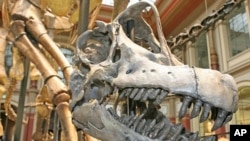Scientists have developed a technique for accurately measuring the body temperature of dinosaurs. Researchers say the highly accurate method for taking the temperature of these enormous creatures raises as many new questions about dinosaur biology as it answers.
U.S. and German scientists have developed a method for measuring the body temperature of sauropods, giant plant-eating dinosaurs that lived during the Jurassic period some 150 million years ago, by analyzing the chemical makeup of 11 fossilized teeth unearthed in Tanzania, Wyoming, and Oklahoma.
Using this so-called chemical thermometer, researchers determined the body temperature of the adult Brachiosaurus, which averaged 23 meters long and weighed about 40 tons. The reptile's normal was 38.2 degrees Celsius and the temperature of a slightly smaller sauropod, the Camasaurus, was 35.7 degrees Celsius.
“It you were to walk up to a living sauropod and put your hand on its side, its temperature would be very similar to your own,” said John Eiler, a professor of geology and geochemistry at the California Institute of Technology in Pasadena and co-author of the study.
But Eiler says the issue is what type of metabolism the animal had. If sauropods had an endothermic metabolism, Eiler says that would have allowed them to generate their own body heat internally like mammals. Creatures that are exothermic rely on the temperature outside their bodies and store heat internally.
Eiler says models have predicted that sauropods had warmer body temperatures than the latest study suggests because of the creatures’ great body size and its presumed ability to store and maintain heat.
Eiler says it’s possible that these Jurassic giants - with their small heads, long necks and giant bodies - were anything but slow, lumbering creatures.
“It’s reasonable to surmise that their enzymes were working efficiently, because they were at a temperature that we know that animal enzymes operate efficiently at and therefore they should have been more vigorous," he said. "What we don’t know is whether they had the metabolic machinery to regenerate energy efficiently the way mammals and birds do, and therefore have endurance.”







